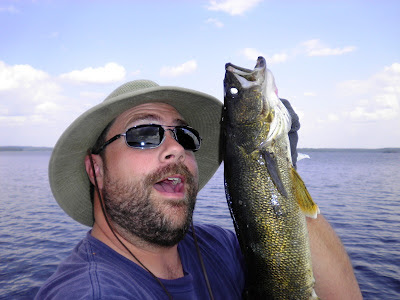
This tub of fish in our fish cleaning hut last summer caught my eye as just about the perfect size walleye and northern pike to keep.
The walleye are about 17 inches in length and the pike are about 26 inches. Incidentally, a 17-inch walleye will easily feed one person and a 26-inch pike will feed at least two.
Ontario fishing regulations for
Zone Four, which includes Red Lake, allow anglers to only have one walleye over 18 inches in their daily or possession limit. They cannot have any pike 27.6-35.4 inches and can only have one pike larger than 35.4 inches.
If you want to ensure there are fish for the future, you should release ALL walleye over 18 inches and northern pike over 27 inches.
Why? These are the big spawners, the brood stock.
But isn't it more ethical to let the small fish go and keep fewer, bigger fish?
Nope, and here's the reason. It's just a matter of mathematics.
Let's take the example of walleye. Let's say
Angler A has a conservation licence that allows him to keep two walleye, one of which could be over 18 inches. So he maximizes his legal catch by keeping one 17-inch walleye and one 26-incher. His buddy,
Angler B, however, keeps two 17-inch walleye.
And to make it easy, let's say the year was 2000.
Walleye produce 26,000 eggs per pound of body weight. A 26-inch female (just about all big fish are females) will weigh about six pounds and therefore will produce 156,000 eggs.
But by the next spring, 2001, she is also an inch bigger. (Walleye grow about two inches a year until they get quite large, then slow down to about an inch, also about a pound, a year.) So in 2001, had she been released, she would have produced 182,000 eggs, 208,000 in 2002, 234,000 in 2003, 260,000 in 2004, 286,000 in 2005 and 312,000 in 2006. She is now 32 inches long, 12 pounds. That is typically about as big as walleye get although some grow larger. We have caught a few 34-inch, 14-pound walleye.
She stops getting longer but she keeps producing eggs for another four years at which point she is about 20 years old and dies of natural causes.
So, had she been released by
Angler A in the year 2000, she would have produced 2,730,000 eggs by 2010.
What effect did
Angler B's choice have?
His 17-inch walleye that he kept instead of a big one, would have spawned for the first time in 2001. Walleye don't spawn until they are 18 inches. But they grow about two inches a year at first so his 17 incher will have grown to 19 inches in 2001 and would weigh about 2 1/2 pounds. It would produce 67,730 eggs in 2001. In 2002 it would be 21 inches and weigh about three pounds and would produce 78,000 eggs. In 2003 it would be 23 inches and weigh 3.5 pounds and produce 91,000 eggs. In 2004 it will be 25 inches and weigh five pounds and produce 130,000 eggs. Now that she is getting older, her growth slows down to one inch a year so in 2005 she is 26 inches and six pounds and produces 156,000 eggs. Then 182,000 in 2006, 208,000 in 2007, 234,000 in 2008, 260,000 in 2009 and 286,000 in 2010.
Her total for the same 10 years is 1,692,730.
Angler A's decision to keep a big fish meant there were 1,037,270 fewer potential fish in the lake over the next decade! More than a million!
Not all eggs survive, of course, and the fertility of old fish drops a little bit in their last years, but you get the picture. Keeping big fish is just about the worst thing you can do for conservation and the future of fishing.
Incidentally, northern pike aren't nearly as prolific as walleye. They produce 9,000 eggs per pound.
Click to go back to our
websiteClick to see the latest on the
blog

















